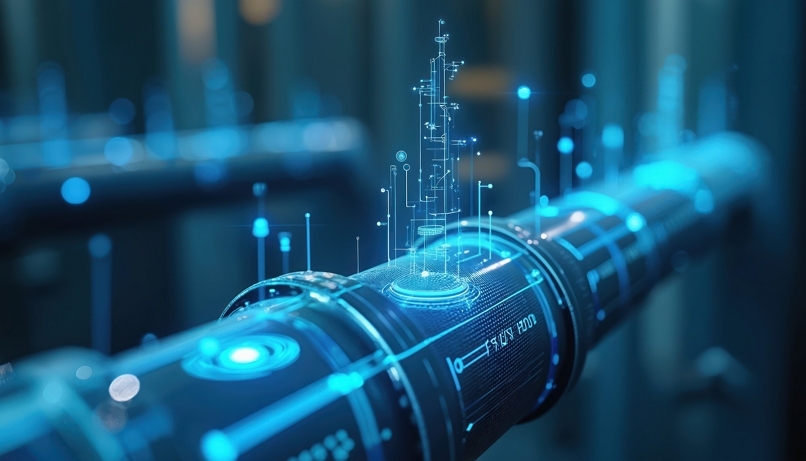In the ever-evolving energy landscape, pipeline infrastructure stands at the cusp of a technological revolution. Traditional pipeline systems (once reliant on manual inspections and reactive maintenance) are being transformed into intelligent, adaptive networks through the convergence of Artificial Intelligence (AI), Edge Computing and the Internet of Things (IoT).
These innovations are giving rise to smart pipelines in the oil and gas industry, enabling predictive maintenance, real-time monitoring, and optimized performance.
This article explores how these next-generation technologies are redefining pipeline operations, enhancing safety and driving efficiency across the oil and gas sector.
For further understanding, please refer to the following blog: “Cybersecurity Basics for Midstream Oil & Gas”.
#From Traditional Pipelines to Smart Infrastructure
Historically, pipeline systems in the oil and gas industry have faced numerous challenges: aging infrastructure, environmental risks, delayed fault detection, and inefficient maintenance cycles.
These traditional pipelines depended heavily on centralized control centers, scheduled inspections, and reactive responses to problems, often after damage had occurred.
The shift toward smart pipelines in oil and gas represents a fundamental change. By integrating advanced technologies like IoT sensors, AI-driven analytics, and decentralized processing power at the edge, pipelines are becoming self-monitoring, self-optimizing systems.
This digital transformation is not just about upgrading hardware; it's about creating a living, learning network that continuously evolves.
#The Role of Edge Computing: Real-Time Processing at the Field Level
One of the most transformative elements in next-gen pipeline infrastructure is edge computing. In traditional systems, data from remote pipeline locations is transmitted to centralized servers for processing. This creates latency, increases bandwidth demands, and delays decision-making.
Edge computing solves these issues by pushing computational power closer to where the data is generated: the field. Smart devices at pump stations, valves, and compression points can now analyze data in real time without waiting for centralized feedback.
This local processing enables:
Faster anomaly detection (e.g., pressure drops, temperature spikes)
Instant emergency responses to potential safety threats
Efficient bandwidth usage by transmitting only critical or pre-processed data to the cloud
For instance, an edge device equipped with AI algorithms can detect unusual vibration patterns in a pipeline segment and shut down flow instantly if a rupture risk is detected, all without cloud involvement.
For a better insight, please refer to the following blog: “Why Cloud-Based Solutions Are Becoming Essential”.
#IoT Sensors: The Eyes and Ears of Smart Pipelines
The backbone of any smart pipeline system is the network of IoT sensors distributed along the infrastructure. These sensors continuously monitor parameters like:
Pressure and flow rate
Temperature
Corrosion levels
Vibration and acoustic emissions
Leak detection using hydrocarbon-sensitive technologies
This rich stream of data feeds into AI in pipeline monitoring, where machine learning algorithms analyze patterns, detect anomalies, and even predict future behavior.
Over time, these systems learn the “normal” behavior of a pipeline and become increasingly accurate at spotting deviations.
By enabling predictive pipeline maintenance, this data-centric approach minimizes downtime, avoids catastrophic failures, and extends the lifecycle of infrastructure.
#Predictive Maintenance: Staying Ahead of Failures
One of the most impactful benefits of next-generation pipeline technologies is the shift from reactive to predictive pipeline maintenance. Traditionally, pipeline operators relied on time-based maintenance, inspecting or servicing components at fixed intervals regardless of their condition.
This often resulted in unnecessary costs or the missed detection of early signs of failure.
With AI analyzing continuous data from IoT sensors, predictive models can now forecast:
When a pump is likely to fail based on vibration and temperature patterns
The rate of corrosion in underground pipes
The weakening of pipeline walls due to pressure fluctuations or chemical exposure
By predicting these events before they occur, operators can perform maintenance only when needed, reducing costs and avoiding unplanned outages. More importantly, predictive maintenance enhances safety by preempting leaks, bursts or hazardous emissions.
#Real-Time Operational Control and Optimization
Beyond maintenance, the integration of AI and edge computing allows for real-time operational control. Smart pipelines can now dynamically adjust their own parameters for optimized performance.
For example:
AI can reroute oil or gas through alternate segments if a blockage is detected
Edge systems can regulate pump speeds to maintain optimal pressure and reduce energy usage
Flow rates can be adjusted automatically based on market demand or supply changes
Such self-regulating behavior increases efficiency, reduces human error, and helps pipelines respond to changing environmental or market conditions in real time.
Additionally, these smart systems contribute to sustainability. By optimizing operations, minimizing waste, and reducing the frequency of leaks, next-generation pipelines can significantly lower their carbon footprint.
For a better understanding, please refer to the following blog: “SaaS in Oil and Gas”.
#Examples of Next-Gen Pipeline Projects and Innovations
The global oil and gas industry is already embracing smart pipeline innovations. Several projects illustrate how AI, IoT, and edge computing are being implemented to revolutionize pipeline infrastructure:
Enbridge’s Smart Pipeline Monitoring
Canadian energy giant Enbridge has invested in a digital pipeline integrity program that leverages IoT sensors and AI algorithms to monitor stress, corrosion, and flow conditions in real time. Their system uses edge devices to process data on-site, reducing latency and enabling immediate intervention.
Trans Mountain Expansion with Smart Technologies
As part of its expansion, the Trans Mountain Pipeline project has incorporated intelligent leak detection systems, real-time flow monitoring, and automated emergency shut-off valves powered by edge computing and AI analytics.
Saudi Aramco’s Digital Twin Pipelines
Saudi Aramco has developed digital twins (virtual replicas of physical pipelines) that use real-time IoT sensor data to simulate, analyze, and optimize operations. These twins allow operators to test different scenarios (e.g., shutdowns, surges) in a virtual environment before applying changes to the real system.
Shell’s Predictive Maintenance Initiative
Shell has implemented AI-driven predictive maintenance across several of its pipeline assets. By analyzing sensor data with machine learning, Shell has reported significant reductions in unplanned downtime and maintenance costs.
#Conclusion
The integration of AI, edge computing, and IoT is reshaping the future of pipeline infrastructure. By enabling smart pipelines in oil and gas, these technologies are not only improving efficiency and reliability but also fundamentally changing how pipelines are operated and maintained.
From predictive pipeline maintenance to real-time operational control, next-generation pipeline systems offer a blueprint for a more intelligent, responsive, and sustainable energy network.
As innovation continues, the oil and gas sector must embrace this digital evolution to stay competitive and resilient in an increasingly complex world.

Table of contents
- From Traditional Pipelines to Smart Infrastructure
- The Role of Edge Computing: Real-Time Processing at the Field Level
- IoT Sensors: The Eyes and Ears of Smart Pipelines
- Predictive Maintenance: Staying Ahead of Failures
- Real-Time Operational Control and Optimization
- Examples of Next-Gen Pipeline Projects and Innovations
- Conclusion



